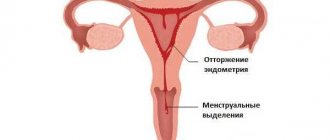Light spotting or heavier bleeding between periods –
one of the common complaints of women of reproductive age. Such bleeding is called intermenstrual, and most often, they are a consequence of one or another pathology in the body.
What is the difference between bleeding and menstruation?
Normally, during menstruation, the amount of blood released is about fifty milliliters. At first, the discharge has a bright shade, then you can notice a gradual darkening of the discharge. The occurrence of blood clots and a small amount of mucus along with bloody vaginal discharge during menstruation is considered normal. The smell is also present, and normally it resembles the smell of raw meat.
A carefully collected anamnesis will help the doctor identify the pathology. The gynecologist may ask about the color, smell and consistency of the bloody discharge.
The main differences between blood discharge during menstruation and pathology:
- In pathology, the bloody mass has a large volume;
- If during menstruation blood comes out of the vagina in portions, then bleeding occurs without interruption;
- No blood clots;
- The discharge is bloody and has a too thin consistency, like water;
- Blood discharge is scarlet in color;
- The appearance of an unpleasant odor that does not resemble the smell of blood;
- The appearance of weakness and pain in the abdomen;
- Unpleasant sensations during sex.
Separately, it is necessary to note the appearance of small bloody discharge after childbirth - lochia. They are easy to distinguish from bleeding after pregnancy, which is a very serious symptom. Lochia is secreted for a month, this is a spotting spotting that has a brownish tint and an unpleasant odor, but, like bleeding, it passes without blood clots.
Blood during ovulation
Every month, girls' bodies undergo changes called the menstrual cycle.
How does the menstrual cycle work?
Every month, an egg matures in the female body. Midway through the cycle, one of the ovaries releases one egg. In April, the left organ released the gamete; in May, the right one will do so. The egg travels down the fallopian tube. If on its way it meets a sperm, it is fixed in the uterus and begins to divide.
During ovulation, liquid blood is observed in small quantities. It signals a rupture of the follicle: small vessels are damaged, hence the blood. A girl notices discharge a week and a half after her period. During the days of ovulation, the greatest fertility is observed: during this period it is easiest to get pregnant.
After labor, discharge appears - lochia. They accompany their mother for an average of 6–8 weeks. Sometimes they stop earlier. The purpose of lochia is to cleanse the uterus of placenta remnants. For the first 2-3 days, normal blood will flow. In a week it will become thicker, and by the end of the first month it will change color to brown. This will indicate the restoration of blood vessels. From the third week, the discharge will become transparent.
Consult a doctor if the discharge lasts less than 5 weeks or for a long time - more than two months, the secretion has a greenish tint, you feel unwell, or feel weak.
If menstrual-like bleeding is profuse - strong, profuse - immediately call an ambulance or go to the doctor: they are caused by unnatural processes. The information on the sites will not give an exact answer why blood appears from the vagina, but this is not menstruation. The best thing to do is to see a doctor. He will prescribe the necessary treatment. Sometimes diseases are eliminated with drugs, sometimes with surgery.
Possible reasons for such discharge
The causes of bleeding in women can be different and indicate the presence of various health problems. If such a symptom appears, you need to consult a gynecologist and not self-medicate, as this will not lead to anything good. With timely treatment, the chances of recovery are higher than with treatment in the later stages of the disease.
Hormonal imbalances
Changes in hormone levels can lead to unpleasant consequences, such as early aging, deterioration in quality of life, infertility and others. Hormonal activity manifests itself during puberty, when a girl begins to have sex. During the period of ovulation, serious changes in hormonal levels can be observed. Menopause is a hormonal imbalance caused by nature, when ovarian activity decreases. Such phenomena are non-pathological.
People who are overweight, eat fast food, do not get any nutrients from food, women who incorrectly use oral contraception, take hormonal medications without a doctor’s prescription, and have bad habits are more likely to experience hormonal imbalances.
The main symptoms of abnormalities in the functioning of the reproductive organs in women:
- Upper body obesity.
- Amenorrhea.
- Chest pain, vomiting, depression before menstruation.
- Acyclic nature of bleeding during menstruation.
If these or other unusual symptoms occur, you should consult a gynecologist.
Inflammatory diseases
Inflammation of the cervix often leads to menstrual irregularities, infertility, and the appearance of cancerous tumors. The exact presence or absence of the disease can only be determined by a gynecologist using special equipment.
Inflammation can be either in the vaginal area or in the cervical canal. The causes of inflammation are infections, for example, staphylococcus, chlamydia, gonococci, dysenteric amoeba, trauma during childbirth or abortion, and other mechanical damage.
Symptoms of inflammation:
- You may notice pus in the vaginal discharge.
- The appearance of bloody brown discharge (daub).
- The appearance of intermenstrual bleeding.
- Pain during sex, itching and burning.
If one of the sexual partners has an infectious disease, you need to use contraception or avoid sex until complete recovery.
Neoplastic processes
Neoplastic processes mean the development of neoplasms. Polyps can be benign, and cancerous tumors can be malignant. The appearance of small bloody discharge from a tumor means the development of tissue with pathology. The intensity of the appearance of blood increases along with the growth of the tumor.
Traumatic injury
There are different types of injuries to the reproductive organs. The main ones are bruise, rupture or perforation of the uterus.
There is a high risk of uterine injury in pregnant women. Typically, such injuries are accompanied by bleeding from the vagina and severe pain. Bruises contribute to abdominal bleeding.
Small uterine ruptures may occur without symptoms. The appearance of bloody discharge in women may indicate the presence of serious damage. In this case, surgery and stitches may be required.
If the walls of the uterus are perforated, abdominal bleeding may develop. The main symptom is severe pain and anemia.
Use of contraception
The main problems that may arise from taking oral contraceptives are delayed bleeding during menstruation and extraordinary bleeding. Usually, before prescribing such drugs, a woman is informed about the possible appearance of undesirable symptoms, including the appearance of spotting when menstruation is delayed.
Discharge after taking medications
Discharge when taking contraceptives is a serious symptom, as it indicates the development of pathologies and requires immediate medical intervention. If in the middle of the menstrual cycle the volume of blood is too large, you need to urgently call a doctor to find out the reason for the appearance of such symptoms. The reasons may be natural, then the blood loss is explained by a lack of estrogen or progesterone.
In medical practice, bleeding can often occur in women who have taken medications independently and without a doctor’s recommendation.
Consequence of hormonal imbalance
The most likely cause of spotting, but not menstruation, is a disturbance in the level of hormones in the body.
The reasons for the imbalance are:
- Stress. If you had a fight with a friend or were nervous during an exam, discharge may appear. Rest and they will stop.
- Physical fatigue. Excessive training in the gym causes hormonal imbalances. Distribute the load correctly: after training you should go home, and not “crawl”. The next day you should have the strength to perform basic actions. Pain is not always a sign of muscle growth.
- Climate change. Arriving to the warm sea from frosty Siberia, girls often notice a delay in their periods by a week or two.
- Diets. Severe restriction in food creates hormonal imbalance. Food should be varied. You can eat anything, even sweets! The only question is in what quantities.
- Anemia. For the most part, spotting indicates a lack of iron in the body. Eat foods rich in ferrum: cottage cheese, fish, legumes, nuts. Iron found in animal foods is absorbed by 50%, and in plant foods – only by 15%.
Diagnosis and treatment
Each disease is diagnosed and treated individually. So, if there are hormonal imbalances, blood is taken to check for estrogen, thyroid hormones, pituitary gland and others.
If a patient comes with a complaint of bleeding and heavy discharge, a doctor’s examination using mirrors can be used as a diagnosis, helping the gynecologist determine the presence of an inflammatory process by swelling and redness.
First, they collect anamnesis, then examine and prescribe treatment. For example, endometriosis can be recognized by the uneven surface of the uterus and corresponding complaints. To confirm the diagnosis, a pelvic ultrasound is performed.
To diagnose endometritis, a bacterioscopic examination of a smear may be required. Ultrasound and endoscopic examinations are often used as diagnostics to monitor and identify changes.
Treatment is different in all cases: it may involve treatment with radio waves, physiotherapy, sometimes the intervention of surgeons is required, in some cases diet and medications such as immunomodulators, antifungals, antibiotics, etc. are sufficient.
Malignant tumors can be removed depending on the location and severity of the disease. In the early stages, you can avoid surgery and chemotherapy and get by with medications used under the supervision of a doctor.
How to stop uterine bleeding at home
It is important to remember that any effective remedy that can stop bleeding cannot replace the help of a doctor. Therefore, in any case, you need to visit specialists to prevent the occurrence of a more serious situation in the future.
To stop bleeding and reduce blood loss, you can use medicinal plants such as shepherd's purse , nettle , and water pepper . They are able to increase the contractility of muscles in the uterine cavity, which helps stop bleeding. The main properties of these herbal remedies are the ability to increase blood clotting, as well as cause constriction of blood vessels that provide blood flow to the uterus.
As a therapeutic effect against bleeding that occurs, you can also use medications that, in combination with herbs, can safely and effectively help stop bleeding. This could be Vitamin C, Dicynon, Vikasol, but even these should be used only on the recommendation of a doctor. Also, in cases where home methods are ineffective and bleeding does not stop for more than three days, it is necessary to urgently consult a specialist.
Which doctor should I contact?
The main doctors you should contact in the absence of menstruation, or, conversely, heavy discharge, are an endocrinologist and a gynecologist. With the help of research and examination, they will be able to identify the presence of diseases such as hypothyroidism or hyperthyroidism, which affects not only the instability of the menstrual cycle, but also the ability to bear children.
If you suspect a tumor, you need to go to an oncologist who can confirm or refute such suspicions and prescribe competent therapy.
If surgery is necessary, you need to contact not only a gynecologist, but also a surgeon, transfusiologist, and anesthesiologist.
What tests and examinations can a doctor prescribe?
The doctor may prescribe both blood and smear tests, as well as X-ray and ultrasound examinations.
The smear can be examined for the presence of bacteria, to determine the type of infection, and to determine the reaction of bacteria to various antibiotics.
Examination of a smear using a microscope helps to detect epithelial cells that are subject to inflammation.
A general analysis of urine and blood will help identify the condition of the blood and possible infections.
The most common methods using medical equipment are colposcopy, ultrasound and x-ray.
The first method involves examining the desired areas using optics to identify inflammatory processes, ultrasound is done to find diseases that cannot be detected during examination or to confirm the diagnosis, x-rays can reveal various pathologies and defects of internal organs.
Treatment of bleeding
Bloody discharge is treated individually based on the diagnosis. Only the attending physician can prescribe medications; treatment with folk remedies or advice on the Internet will not be able to eliminate the causes of the unpleasant symptom, and in some cases it will aggravate the situation.
A woman at any age needs to take care of her health; special attention should be paid to the condition of the body when planning pregnancy and before childbirth.
Diseases such as hormonal changes, ectopic pregnancy, and tumors not only cause discomfort and pain, including weakness and malaise, but also pose a threat to a woman’s life and cause infertility.
Regular visits to doctors will help avoid complications and start therapy on time.










